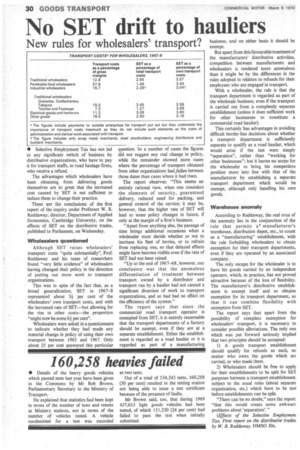160,258 heavies failed
Page 32

If you've noticed an error in this article please click here to report it so we can fix it.
• Details of the heavy goods vehicles which passed tests last year have been given in the Commons by Mr Bob Brown, Parliamentary Secretary to the Ministry of Transport.
He explained that statistics had been kept in terms of the number of tests and retests at Ministry stations, not in terms of the number of vehicles tested. A vehicle resubmitted for a test was recorded as two tests.
Out of a total of 534,243 tests, 160,258 (30 per cent) resulted in the testing station not being able to issue a test certificate because of the presence of faults.
Mr Brown said, too, that during 1969 437,013 light goods vehicles had been tested, of which 151,230 (24 per cent) had failed to pass the test when initially submitted. business, and on either basis it should be exempt.
But apart from this favourable treatment of the manufacturers' distributive activities, competition between manufacturers and wholesalers is rendered more anomalous than it might be by the differences in the rules adopted in relation to refunds for their employees who are engaged in transport.
With a wholesaler, the rule is that the transport department is regarded as part of the wholesale business, even if the transport is carried out from a completely separate establishment (unless it does sufficient work for other businesses• to constitute a commercial road haulier).
This certainly has advantages in avoiding difficult border-line decisions about whether a transport department is sufficiently separate to qualify as a road haulier, which would arise if the test were simply "separation", rather than "working for other businesses"; but it leaves no scope for the wholesaler to bring his competitive position more into line with that of the manufacturer by establishing a separate transport department which would be exempt, although only handling his own goods.
Warehouse anomaly According to Reddaway, the real crux of the anomaly lies in the conjunction of the rule that permits a' manufacturer's warehouse, distribution depot, etc., to count as a "manufacturing" establishment, with the rule forbidding wholesalers to obtain exemption for their transport departments, even if they are operated by an associated company.
The only escape for the wholesaler is to have his goods carried by an independent operator, which, in practice, has not proved attractive because of the loss of flexibility. The manufacturer's distributive establish ment is exempt itself and so obtains exemption for its transport department, so that it can combine flexibility with exemption from SET.
The report says that apart from the possibility of complete exemption for wholesalers' transport, it is necessary to consider possible alleviations. The only one which was put forward seriously implied that two principles should be accepted: 1) A goods transport establishment should qualify for refunds as such, no matter who owns the goods which arc carried, or who made them.
2) Wholesalers should be free to apply for their establishments to be split for SET purposes between a transport establishment subject to the usual rules (about separatc organization, etc.) which have to be mel before establishments can be split.
"There can be no doubt," says the report "that this would create some awkwarc problems about 'separation'."
(*eels of the Selective Employmen, Tax. First report on the distributive trades, by W. B. Reddaway. HMSO 30s.




























































































































































